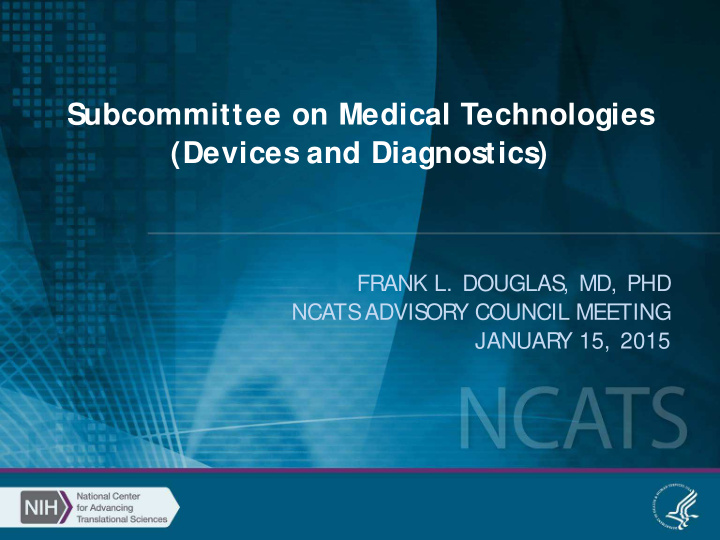



Subcommittee on Medical Technologies (Devices and Diagnostics) FRANK L. DOUGLAS , MD, PHD NCATS ADVIS OR Y COUNCIL MEETING JANUAR Y 15, 2015
Council: Frank L Douglas, Paul Yock, Co-Chairs Members: Margaret Anderson, Bob Tepper, Scott Weir, Sue Siegel NCATS Support: Stephen Groft, Carson Loomis, Elaine Collier, Sitta Sittampalam, Anton Simeonov, Danilo Tagle, Rashmi Gopal-Srivastava NIBIB: Bill Heetderks, Todd Merchak FDA: Jeff Shuren CMS: Louis Jacques
NIH Medical Device Portfolio Analysis Bill Heetderks and Todd Merchak, NIBIB Background: No NIH Research, Condition and Disease Categorization (RCDC) system code for “medical devices” exists Medical device category including subcategories was drafted NIH grant database coded using the draft category Trans-NIH assessment of reasonableness of the framework
Subcategories of Medical Devices Assistive Imaging Surgical Diagnostic Implant • Detector • Ablation • Assays • Artificial • Brain computer • Endoscopy • Biopsy • Biosensor pancreas interface • Medical • Deep brain • ECG,EEG,MEG • 3D Tissue • Cochlear imaging stimulation • In-vitro printer implants • MRI • Laparoscopy diagnostics • Biocompatible • Neuro- • Optical • Radiation • Monitoring materials stimulation • PET/SPECT therapy device • Catheters • Prostheses • Ultrasound • Ultrasound • Microfluidics • Stents • Rehabilitation • X‐Ray therapy • Point of care • Ventricular assist device
Conclusions of NIH Portfolio Analysis Diagnostic and imaging account for 60% of the grants; the other three categories 40% Five Institutes (NCI,NIBIB,NHLBI, NIGMS and NINDS) support 50% of the grants Roughly equal split between grants for pre-clinical development & testing and clinical testing Diversity of medical devices research across the translational spectrum supported by NIH Medical technology accounts for one third of all SBIR grants
NCATS Opportunities with Medical Technologies Address systemic issues in development and implementation of medical devices for all applications including diagnostics Enhance collaboration and cooperation in medical device research among stakeholders Education and training of workforce Define knowledge gaps and resource requirements
Recommendations • Convene experts and stakeholders in workshops and conferences on specific challenges in medical devices, e.g., Legal and IP Reimbursement Business plans, models and market analysis Clinical need, usability and validity Team science of medical device collaborations Engage new communities in device development
Recommendations • Engage all stakeholders, (e.g., academic, commercial, patients, payers, research and regulatory agencies) in addressing gaps in knowledge and resources for investigators/clinicians/ engineers (and trainees) to move products from discovery to patients: Understand CTSA landscape for training and educational resources in medical device development Learn from SBIR’s new commercialization training programs (Lean, I-Corps, other commercial programs) Provide advisors/mentors/staff with expertise in regulatory, reimbursement and other commercialization strategies
Recommendations • Addressing gaps in knowledge and resources (continued): Involve other programs at NIH (e.g., NCI, NHLBI, NIBIB) and other government departments (e.g., FDA, CDC, DARPA) Involve Pharm/biotech/VC (PBV) community for guidance and for identifying opportunities Include new industry entrants in the Medical Devices field.
Recommend
More recommend